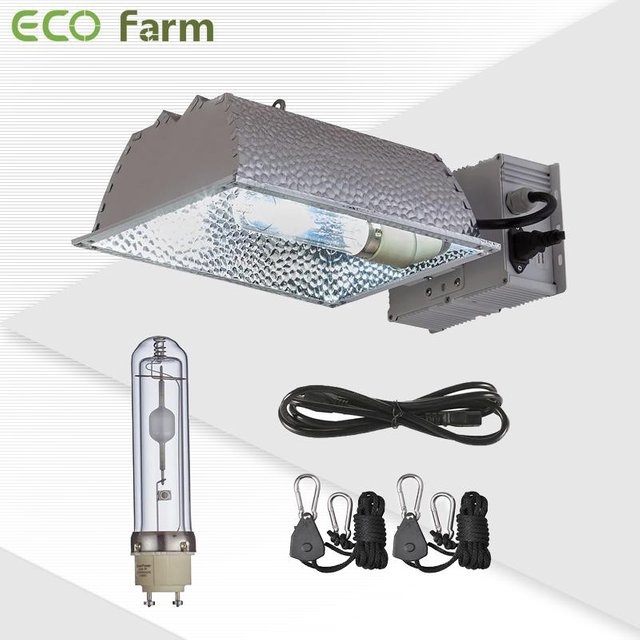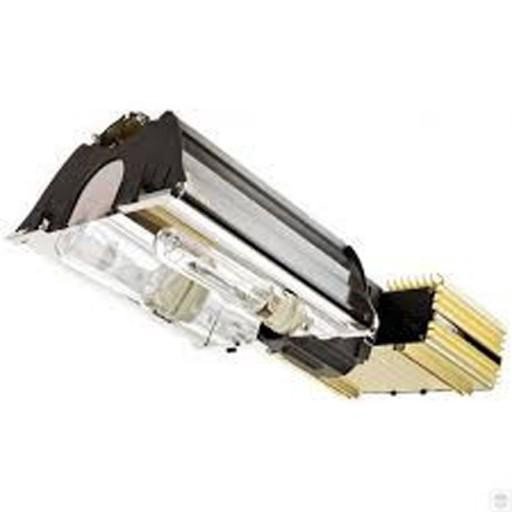ECO Farm CMH 315W Grow Light Fixture Reflector Enclosed Kit VS DimLux Expert Series 315W CMH Full Spectrum Complete Grow Light Fixture
If you intend to grow plants indoors, one of the first troubles you may face is how you provide your plants with enough lights.
Of course, not anything can beat the natural sunlight when it comes to growing. However, technology has made it easy and viable with growing lights for an indoor garden. There are discernible benefits of choosing what kinds of lights, how much, and how long of lightning you expose to plants. In fact, grow lights have been used widely over the world either in hobbyists’ apartments or large-scale greenhouse farms.
What Is A Ceramic Metal Halide?
Ceramic metal halide, or CMH in short, is a newer variation of the metal halide lamps. This improved version uses ceramic rather than the traditional quartz. By using a ceramic material, it enables the lamp to operate at a higher arc tube temperature.
In that manner, it increases its performance efficiency by 10% to 20% higher than older MH lamps. To add, the quality of the color shift and its spread stability is also enhanced. CMH also has better rendering at 80–96 CRI.
So, how does a ceramic metal halide work?
The arc tube in the CMH grow light contains a starting gas. Gases such as argon, mercury, and metal halide salts fill in the ceramic tube. During the operation, the temperature of this tube can reach more than 1,200 kelvins. Because of that intense heat, partial vaporization of the MH salts occurs. Thus, dissociating the salts into metallic atoms and iodine.
The gas mixture enables the ballast to deliver a high starting voltage. This combination needs to ionize first before the current can flow through. Thus, powering the lamp.
The metallic atoms are the primary source of light in CMH. It produces a bluish light with a CRI of up to 96. This kind of light is like that of natural daylight. The actual color though will vary depending on the specific mixture of MH salts used.
Why do plants need light?
All living things need the energy to grow. Human beings get energy from food. Plants get energy from light through a process called photosynthesis. The photosynthesis reaction can be explained as follows
Carbon dioxide + water + (light energy) –> glucose + oxygen
During this process, plants get light energy through chlorophyll in their leaves. The energy is used to make carbon dioxide (from the air) react with water (absorbed by the roots and transferred to the stem and leaves) to create a sugar called glucose. This sugar is consumed in respiration or transformed into starch, then stored. Oxygen is made as the process’ by-product.
Below is a comparison of the two best CMH grow lights, I hope it can be helpful to you.
ECO Farm CMH 315W Grow Light Fixture Reflector Enclosed Kit
Features:
ECO Farm CMH grow light is a intensity, full-spectrum lamp: Closer to natural sunlight than a typical high-intensity discharge (HID) system, this lamp uses a full-spectrum to nourish plants and stimulate the resin to produce a far-red ultraviolet spectrum. Covering an area of 4 feet * 4 feet, which means greater harvest and lower costs, the light is optimized for the blooming stage and has an enhanced red color.
The professional result becomes simple: Compared with traditional lighting settings, this CMH kit runs significantly cooler, without the need for pipes and fans for cooling; energy is not lost during heating.
High-tech ballast: The cutting-edge adjustable ballast adopts advanced low-frequency square wave technology, which is efficient, reliable and without electromagnetic interference. Ultra-high reflectivity: The sturdy reflector is made of German aluminum and is rated at 98% reflectivity; contour design and texture eliminate hot spots and dead zones
DimLux Expert Series 315W CMH Full Spectrum Complete Grow Light Fixture
Features:
DimLux Expert CMH grow light has the best flow, less heat and more light! Adjustable side reflectors provide better light overlap and minimize any losses on the wall.
Made of attractive 98% reflective Miro Silver aluminum, the 50mm socket on the reflector can be used to significantly reduce the room temperature by actively extracting air. An optional additional reflector can be used to minimize wall losses.
Very good and efficient-1.9 micromole (umol) power output per watt, extremely high PAR level
Its brightness is as bright as the equivalent wattage in HPS, providing you with the best of both worlds-the device provides LEP-style spectrum and HPS-style intensity!
The Advantages of CMH Grow Lights
CMH lights are an excellent choice for the gardener who is serious about perking up the flowering process. They are the perfect choice for growers who have had problems with other grow lights that have grown out of date or unreliable.
The biggest advantage that CMH lights have over other types of grow lights is their combination of the light spectrum in which plants thrive and the quality of the light. CMH lights are formed by mixing a blue and a red light together to create the violet and white spectrum. This spectrum is ideal for the flowering process and will enhance the buds you grow by increasing their potency.
CMH lights come with a very long life, when they are cared for properly, and deliver a high light intensity without having to run them very long. They are ideal for situations in which space is at a premium because they are so efficient.
CMH lights are the best lights for any cultivation process because of the quality of the light they produce and the fact that they will enhance your yields, allowing you to grow bigger and better harvests.
The CMH Grow Light Spectrum
If you are using a vegetative propagation light, you want to mimic the light of spring and summer, when the plant is primarily growing new leaves and stems. Red, left-hand side of the spectrum (like the sun) is perfect for that.
CMH are best used in the vegetative stage, and are particularly good for fruiting plants. Their output is far more blue, which is perfect for an abundance of fruit and flowers at the end of the vegetative stage.
CMH grow lights can be used up until maturity, but tend to be a bit less effective in the flower stage. That is because they aren’t as powerful as High Intensity Discharge lights and tend to take up more space. If the grow space is limited, you might want to switch back to HID lights before flowering.
They come in two types: linear and circular arrays. Linear fixtures, though they might seem less expensive, are often not a good buy because they direct light onto the plant in a small, narrow beam. As a result, the plant grows up and out, rather than down and out. A broad-beamed circular array with a cylindrical solid cover will get more light onto the plant and is a better fixture for the same money.
CMH vs. MH
As MH lights tend to be heavy on the blue part of the spectrum, the overall balanced spectrum of CMH lights is better especially with the added boost of red at 3100k and 4000k spectrums.
CMH lights emit less heat and they’re more PAR efficient when compared watt per watt. They also last longer than MH lights, as their lifespan is almost twice the amount of hours at 24,000 hours.
CMH vs. HPS
HPS is considered the king of flowering crops, as most of the PAR light it produces is a red light, which is perfect for plants in their flowering or fruiting phase. However, the amount of blue light it produces is not enough to cover their growth phase.
This results in weak and spindly plants.
Once again, the balanced CMH spectrum comes to the rescue, as it produces more PAR light per watt, which is best for every phase of the growth cycle. They’re also cooler than HPS.
A combination of both lights is the ideal arrangement for optimum plant growth.
HPS degrade a lot faster than CMH lights and will need to be replaced after the 9,000th hour.
CMH vs. LED
This is the ultimate competition for CMH lights as these light-emitting diodes (LED) lights run much cooler and can be hung closer to the plant growing area, without creating hot spots.
Because of their placement (6 inches above the canopy), however, LED lights can penetrate at a limited depth of 6 inches into the canopy, whereas CMH lights are hung 3 feet above and can penetrate at a range of 18 to 24 inches.
This means that LED lights are suitable for low ceilings and lighting underneath a canopy.
Although it may seem like a disadvantage that you have to replace the bulb with others that have a bit more red (3100k) or a bit more blue (4000k) for a specific growth stage, however, it’s more efficient than turning off the red or blue diodes in the LED lights.
This will limit the amount of light produced from the system significantly and reduce the overall efficiency of the lights, compared to that of CMH grow lights.
The upfront cost of LED lights is also noteworthy, as it costs around $900, which is almost twice or 4 times that of the CMH system. This makes CMH lights a more affordable option.
Some manufacturers of LED lights don’t provide factual information about their products, which can lead to under performing lights.
Conclusion
There are advantages to all grow lights. While some growers may prefer HID or LED lighting for their specific needs, a CMH grow light might be perfect for your grow room. CMHs offer large coverage at a lower wattage, a wide spectrum of light including UV light, and low power consumption.
CMH grow lights are ideal for anyone from seasoned growers with large tents to first-timers who are growing one or two plants. You really can’t go wrong with a good CMH light in your grow room.

